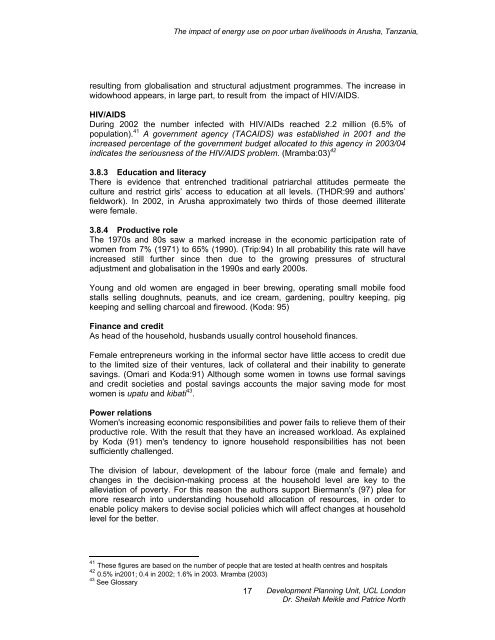The Impact of Energy Use on Poor Urban Livelihoods in ... - DfID
The Impact of Energy Use on Poor Urban Livelihoods in ... - DfID
The Impact of Energy Use on Poor Urban Livelihoods in ... - DfID
You also want an ePaper? Increase the reach of your titles
YUMPU automatically turns print PDFs into web optimized ePapers that Google loves.
<str<strong>on</strong>g>The</str<strong>on</strong>g> impact <str<strong>on</strong>g>of</str<strong>on</strong>g> energy use <strong>on</strong> poor urban livelihoods <strong>in</strong> Arusha, Tanzania,<br />
result<strong>in</strong>g from globalisati<strong>on</strong> and structural adjustment programmes. <str<strong>on</strong>g>The</str<strong>on</strong>g> <strong>in</strong>crease <strong>in</strong><br />
widowhood appears, <strong>in</strong> large part, to result from the impact <str<strong>on</strong>g>of</str<strong>on</strong>g> HIV/AIDS.<br />
HIV/AIDS<br />
Dur<strong>in</strong>g 2002 the number <strong>in</strong>fected with HIV/AIDs reached 2.2 milli<strong>on</strong> (6.5% <str<strong>on</strong>g>of</str<strong>on</strong>g><br />
populati<strong>on</strong>). 41 A government agency (TACAIDS) was established <strong>in</strong> 2001 and the<br />
<strong>in</strong>creased percentage <str<strong>on</strong>g>of</str<strong>on</strong>g> the government budget allocated to this agency <strong>in</strong> 2003/04<br />
<strong>in</strong>dicates the seriousness <str<strong>on</strong>g>of</str<strong>on</strong>g> the HIV/AIDS problem. (Mramba:03) 42<br />
3.8.3 Educati<strong>on</strong> and literacy<br />
<str<strong>on</strong>g>The</str<strong>on</strong>g>re is evidence that entrenched traditi<strong>on</strong>al patriarchal attitudes permeate the<br />
culture and restrict girls’ access to educati<strong>on</strong> at all levels. (THDR:99 and authors’<br />
fieldwork). In 2002, <strong>in</strong> Arusha approximately two thirds <str<strong>on</strong>g>of</str<strong>on</strong>g> those deemed illiterate<br />
were female.<br />
3.8.4 Productive role<br />
<str<strong>on</strong>g>The</str<strong>on</strong>g> 1970s and 80s saw a marked <strong>in</strong>crease <strong>in</strong> the ec<strong>on</strong>omic participati<strong>on</strong> rate <str<strong>on</strong>g>of</str<strong>on</strong>g><br />
women from 7% (1971) to 65% (1990). (Trip:94) In all probability this rate will have<br />
<strong>in</strong>creased still further s<strong>in</strong>ce then due to the grow<strong>in</strong>g pressures <str<strong>on</strong>g>of</str<strong>on</strong>g> structural<br />
adjustment and globalisati<strong>on</strong> <strong>in</strong> the 1990s and early 2000s.<br />
Young and old women are engaged <strong>in</strong> beer brew<strong>in</strong>g, operat<strong>in</strong>g small mobile food<br />
stalls sell<strong>in</strong>g doughnuts, peanuts, and ice cream, garden<strong>in</strong>g, poultry keep<strong>in</strong>g, pig<br />
keep<strong>in</strong>g and sell<strong>in</strong>g charcoal and firewood. (Koda: 95)<br />
F<strong>in</strong>ance and credit<br />
As head <str<strong>on</strong>g>of</str<strong>on</strong>g> the household, husbands usually c<strong>on</strong>trol household f<strong>in</strong>ances.<br />
Female entrepreneurs work<strong>in</strong>g <strong>in</strong> the <strong>in</strong>formal sector have little access to credit due<br />
to the limited size <str<strong>on</strong>g>of</str<strong>on</strong>g> their ventures, lack <str<strong>on</strong>g>of</str<strong>on</strong>g> collateral and their <strong>in</strong>ability to generate<br />
sav<strong>in</strong>gs. (Omari and Koda:91) Although some women <strong>in</strong> towns use formal sav<strong>in</strong>gs<br />
and credit societies and postal sav<strong>in</strong>gs accounts the major sav<strong>in</strong>g mode for most<br />
women is upatu and kibati 43 .<br />
Power relati<strong>on</strong>s<br />
Women's <strong>in</strong>creas<strong>in</strong>g ec<strong>on</strong>omic resp<strong>on</strong>sibilities and power fails to relieve them <str<strong>on</strong>g>of</str<strong>on</strong>g> their<br />
productive role. With the result that they have an <strong>in</strong>creased workload. As expla<strong>in</strong>ed<br />
by Koda (91) men's tendency to ignore household resp<strong>on</strong>sibilities has not been<br />
sufficiently challenged.<br />
<str<strong>on</strong>g>The</str<strong>on</strong>g> divisi<strong>on</strong> <str<strong>on</strong>g>of</str<strong>on</strong>g> labour, development <str<strong>on</strong>g>of</str<strong>on</strong>g> the labour force (male and female) and<br />
changes <strong>in</strong> the decisi<strong>on</strong>-mak<strong>in</strong>g process at the household level are key to the<br />
alleviati<strong>on</strong> <str<strong>on</strong>g>of</str<strong>on</strong>g> poverty. For this reas<strong>on</strong> the authors support Biermann's (97) plea for<br />
more research <strong>in</strong>to understand<strong>in</strong>g household allocati<strong>on</strong> <str<strong>on</strong>g>of</str<strong>on</strong>g> resources, <strong>in</strong> order to<br />
enable policy makers to devise social policies which will affect changes at household<br />
level for the better.<br />
41 <str<strong>on</strong>g>The</str<strong>on</strong>g>se figures are based <strong>on</strong> the number <str<strong>on</strong>g>of</str<strong>on</strong>g> people that are tested at health centres and hospitals<br />
42 0.5% <strong>in</strong>2001; 0.4 <strong>in</strong> 2002; 1.6% <strong>in</strong> 2003. Mramba (2003)<br />
43 See Glossary<br />
17<br />
Development Plann<strong>in</strong>g Unit, UCL L<strong>on</strong>d<strong>on</strong><br />
Dr. Sheilah Meikle and Patrice North
















